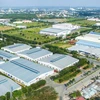HCM City (VNA) – With its value in nutrition and medicine, Vietnamese seaweed has seen strong market demand, requiring producers to seek measures to boost production and exports.
In 2015, Vietnam had over 10,000 hectares of seaweed farm, including 8,200 hectares of gracilaria. However, the country’s total annual natural seaweed output is only 56,000 tonnes of fresh seaweed or 8,000 tonnes of dried seaweed.
Seaweed production in the southern provinces of Ninh Thuan and Binh Thuan, the two largest seaweed producers, has been low at only 3.5 tonnes per hectare of fresh seaweed each year, due to a lack of adequate investment.
Tran Cong Khoi, deputy head of the Department of Aquatic Farming under the Ministry of Agriculture and Rural Development, held that in order to increase seaweed yield to meet export demand, it is necessary to expand seaweed farming in the sea as well as around islands and in lagoons, which also benefits the environment there.
At the same time, seaweed processors should improve their technologies and diversify their products to meet the increasing demands of foreign markets, while offering technical training to seaweed farmers and enhancing seaweed varieties, he said.
According to the Institute for Biological Technology and Environment under Nha Trang University , more than 800 species of seaweed have been found in Vietnam , including over 400 species of red Rhodophyta algae, 180 species of green and 140 species of brown algae.
Ngo Dang Nghia, director of the institute, said that seaweed is rich in nutrients, which provide various vitamins, protein, fibre and minerals. Some kinds of seaweed can also help eradicate radioactivity from a human’s body, he said.
Seaweed is used as a foodstuff and in food processing, as well as cosmetics and medical industries, said Nghia.-VNA























